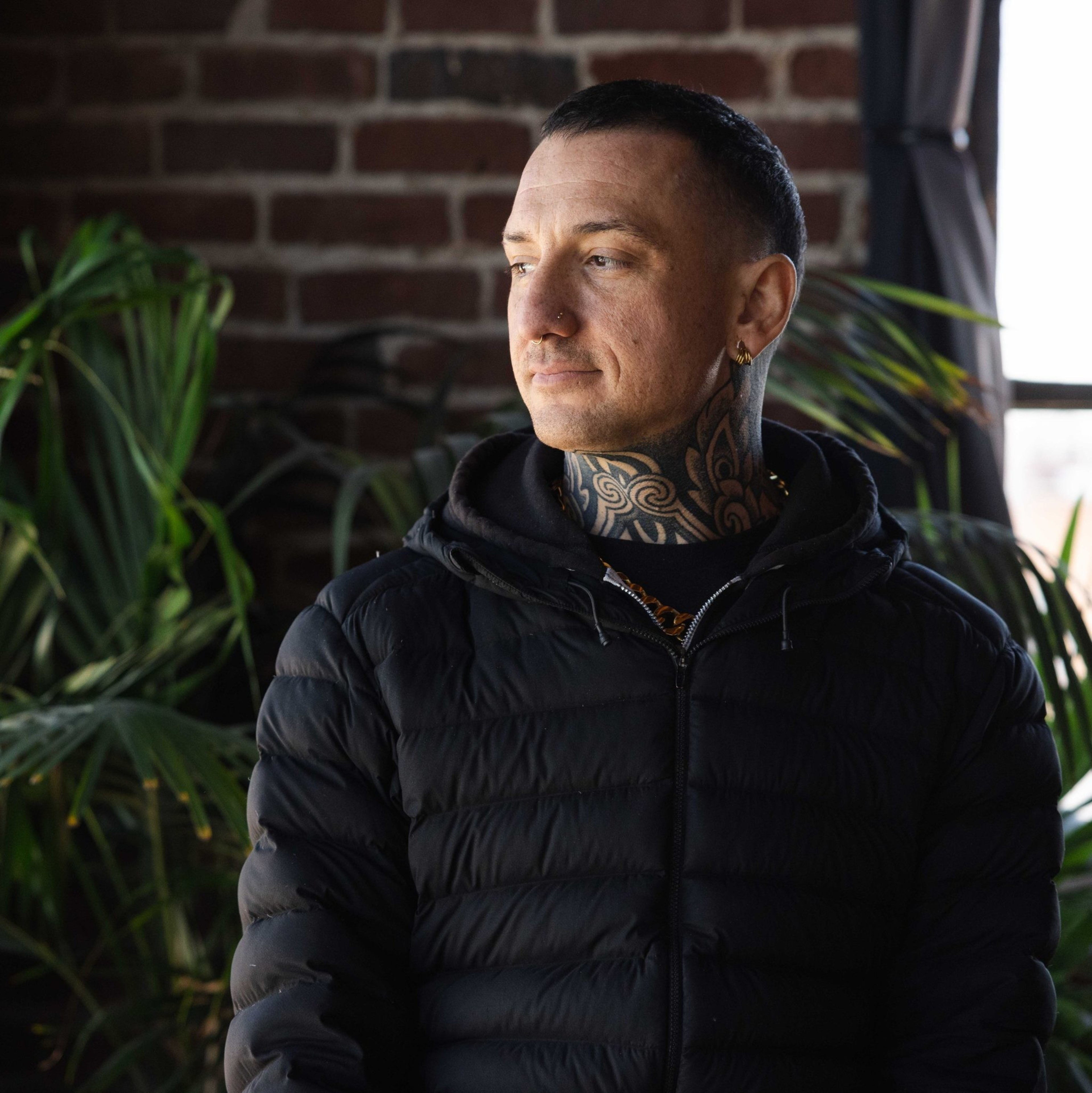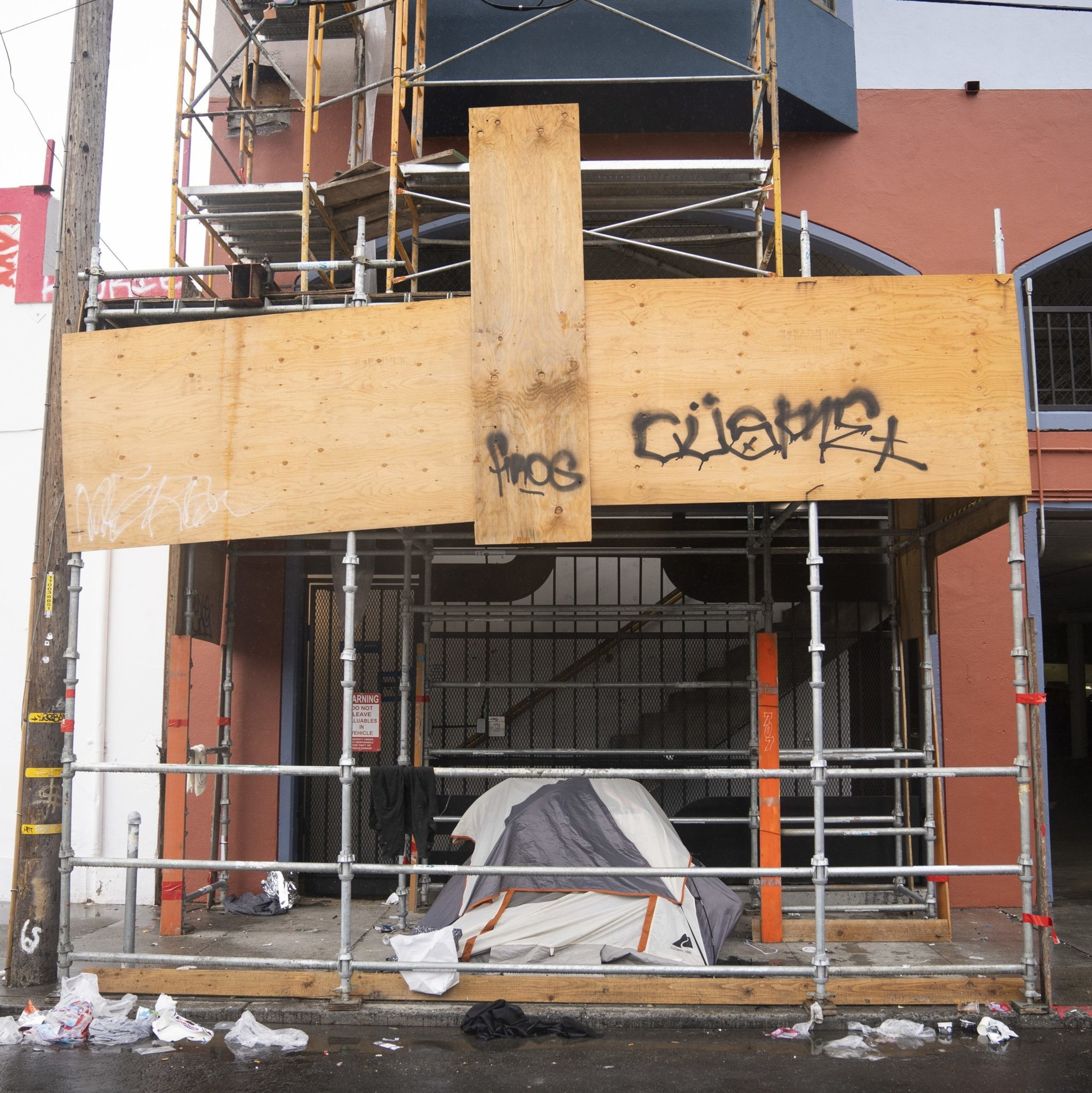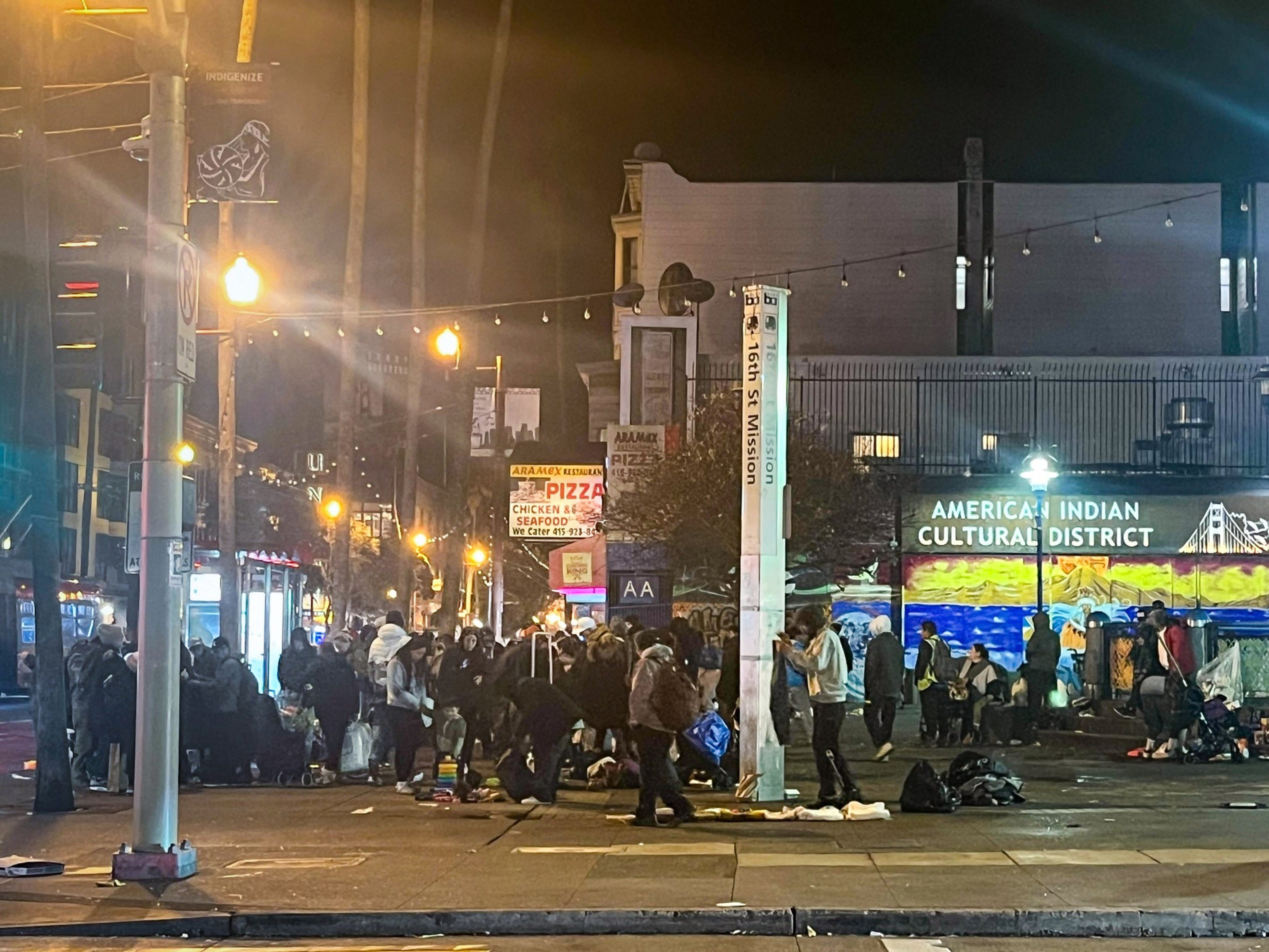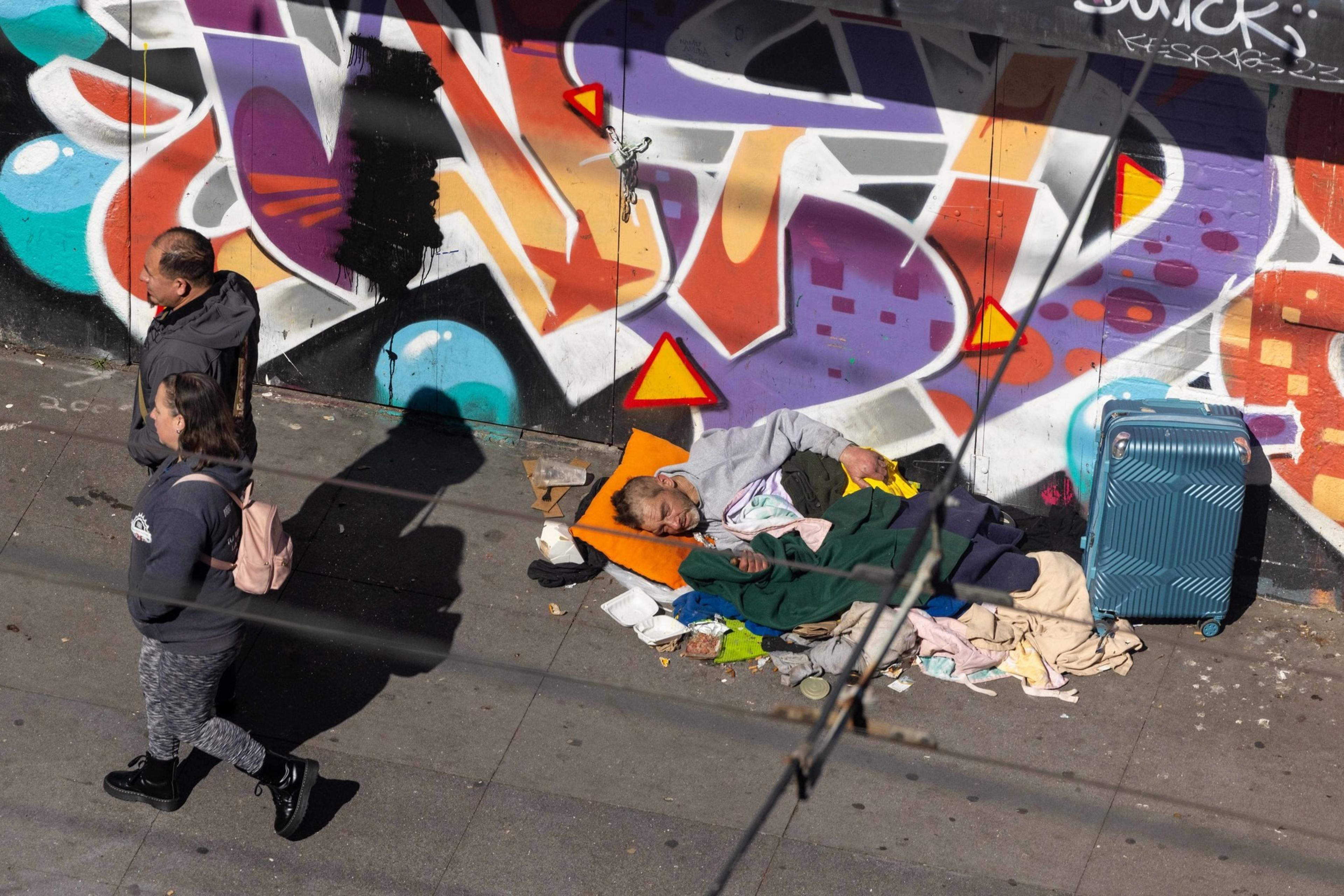They say change doesn’t happen overnight.
But on San Francisco’s infamous Sixth Street in SoMa, the situation has evolved considerably in just a few weeks. As recently as Jan. 22, the corridor was bustling with drug users, dealers, violence, and illegal vending. Now, the shift is so significant that locals are finding it hard to believe.
“It’s quite a major change,” Jack Sinow said as he walked down a mostly clear sidewalk toward his 50-year-old optometry business on Sixth. “I would say that’s wonderful.”
The crowds were gone from their usual corners Wednesday night when The Standard visited. The sidewalks had been power-washed. A handful of people still loitered in alleys. But after an increase in drug arrests in recent months, more than 200 of which took place on Sixth, most of the regulars were absent.
Where did they go?
You don’t have to look far to find one explanation: They’re in the Mission.
On Wednesday night, The Standard spotted roughly 50 people using and selling drugs or illegally buying and selling goods at the 16th Street BART station.
“Conditions are the worst I’ve ever seen,” said Bryan Tublin, owner of Kitava, a restaurant near the station. “My staff has to hop over people doing hard drugs just to get to work every day.”
On multiple occasions in the last 10 days, Tublin said, his restaurant’s front and back entrances were blocked by drug users. He said a man walked into the restaurant and soiled himself as customers dined Sunday.
“My staff almost threw up,” Tublin said. “I don’t have all the answers, but we shouldn’t be the ones paying the price.”

Around the corner at the Haum yoga studio, owner Danni Pomplun said he’s lost 60% of the teachers at his Mission location in the last year due to safety concerns. He said the neighborhood saw an influx of drug activity about a year ago, but the issue has worsened over the past couple of months, leading to a decline in customers at the studio.
“People don’t want to come in anymore,” Pomplun said. “The city doesn’t make running a small business easy.”
In a statement, Charles Lutvak, spokesman for Mayor Daniel Lurie, suggested the problems are the cumulative legacy of failures by past administrations to address illegal drug activity. Now, he said, “the Lurie administration is creatively and relentlessly tackling these challenges, and that’s what we will do until they are resolved — not just on one street but everywhere in our city.”

Maurice Stall, who lives in the SoMa neighborhood, said he’s familiar with being booted off his favorite perch on the corner of Sixth and Jessie streets, where he has been a regular for 39 years, occasionally sipping from a tall boy stashed in his jacket pocket.
Known on the streets as Shauny Moe, the San Francisco native and Balboa High School alum said drug users relocated because Sixth Street is shut down.
“It’s over,” he said. “Sixth Street is cool, but 16th Street is cooler.”
‘The San Francisco shuffle’
Long troubled by drug use and homelessness, Sixth Street is also home to bars, restaurants, and other small businesses whose owners are fed up with the persistent chaos.
Beyond addressing the human misery, the city’s ability to clean up the street may determine its economic future. Lurie is banking on the revival of downtown and SoMa, crucial to closing the city’s $840 million budget gap, which may soon lead to major cuts in services.
In August 2023, when Nordstrom left the San Francisco Centre mall and the outlook for business downtown was bleak, Ikea opened near Sixth, lifting hopes of restoring the area’s status as a bustling hub. But a year later, staffers at the Swedish furniture giant were warning city officials that conditions must change.
Police have shifted their drug enforcement operations this year from the Tenderloin to SoMa, with a focus on Sixth Street, department data show.

On Feb. 7, the city opened a triage center in the former Nordstrom parking lot along Sixth. The facility was conceived as a hub for police to quickly process arrests or connect drug users to treatment.
In its first three days of operation, the triage center had 546 visitors, according to an internal department head briefing. Of those, 21 were placed in shelter beds, and 63 received “treatment,” though the briefing did not clarify what that meant — the definition could range from being placed in a support program to receiving anti-opioid medication.
No arrests were processed at the triage center, and no visitors were placed in the Journey Home program that buses people to other cities. The mayor’s office didn’t provide updated data by publication time.
But as one problem zone dissipates, another appears.
“It’s the San Francisco shuffle,” Pomplun said. “Let’s just move people around.”

Moving drug users comes with other issues, according to service providers. Displacement makes them more likely to die of an overdose as they resort to using in isolation or in unfamiliar circumstances, said Lydia Bransten, who runs the Gubbio Project, a Mission nonprofit that provides services for homeless people.
Overdose deaths in San Francisco spiked from 49 in December to 59 in January, according to preliminary data from the chief medical examiner.
“When you take someone out of their usual routine, you’re agitating a person who is already in a state of crisis,” Bransten said. “People don’t disappear. People don’t change behaviors overnight.”
‘The drug dealers adapt’
Shuffling the fentanyl epidemic between neighborhoods offers temporary relief at best, city officials have said.
“The drug trade is spreading into neighborhoods it hasn’t traditionally been in,” Supervisor Bilal Mahmood said. “The drug dealers adapt. The illegal street vendors adapt.”
Mahmood announced Thursday that he’s asking his colleagues on the board to urge Lurie to adopt a “drug market intervention strategy” pioneered by David Kennedy of the John Jay College of Criminal Justice, who gave expert testimony to the Obama administration’s Task Force on 21st Century Policing (opens in new tab).
The strategy would deploy more unarmed ambassadors on night patrols with the goal of preventing drug markets from reappearing once they’ve been disbanded. It would also fund programs designed to give new opportunities to those involved in the drug trade.
Lutvak, the mayor’s spokesman, pointed to efforts already in place. “Every day, dedicated city teams are spread out across the Mission, enforcing the law, cleaning the streets, and maintaining quality of life,” he said. “These operations are already underway and will continue to expand in the coming weeks to preserve safety and public space in the Mission, just like we do in every neighborhood.”
Along Mission Street Thursday night, throngs of drug users lined the sidewalk around the 16th Street BART station. Vendors sold paper towels and liquor while users smoked drugs openly and others yelled from double-parked cars.

The Mission’s supervisor, Jackie Fielder, said the displacement of drug users was an obvious outcome of leaning too heavily on short-term solutions.
“I’ve warned them all about the displacement,” Fielder said. “Without scaling a serious plan for treatment, for mental health beds, we’re not going to see serious results, and we’re just going to continue the cat-and-mouse game that’s been playing out.”
She has called for the city to adopt a drug prevention model that originated in Zurich, Switzerland (opens in new tab), and involves providing safe consumption sites for users, leaning away from abstinence-based assistance, and enforcing the law against dealers.
It may be a tough sell — San Francisco officials, including Lurie, have responded to frustrated residents by promising to move away from harm reduction, embracing treatment or jail to helping drug users.
On Wednesday, barricades had been installed on Wiese Street, a Mission alleyway known as a drug hot spot, prohibiting people from gathering on the sidewalks. Around 10 a.m., a police car cruised by and dispersed a small group that had gathered there.

A homeless man named Ray O., who declined to give his full name, said the constant displacement is taxing. He’s lost thousands of dollars worth of items in encampment sweeps, he said. But he doesn’t want to sleep in a shelter, believing they are less safe than the streets.
After the police moved his group along, The Standard asked Ray where he and the others planned to go next.
“There’s no telling,” he said.
